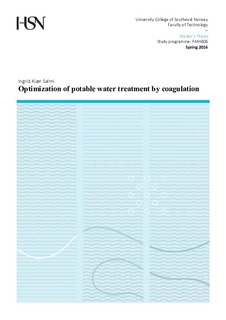Optimization of postable water treatment by coagulation
Master thesis
Permanent lenke
http://hdl.handle.net/11250/2478967Utgivelsesdato
2016Metadata
Vis full innførselSamlinger
Sammendrag
Securing hygienic barriers and also removal of particles, natural organic matter and dissolved minerals are necessary factors in the treatment of surface water. The presence of natural organic matter has increased during the last years in Seierstad’s water source Farris and there is a desire to remove organic matter more efficiently at an early stage in the process. The main objective of this thesis is to evaluate alternative coagulants and dosages in order to improve Seierstad’s potable water treatment process. The evaluation regards cost and water quality. A Jar test and a pilot plant at Seierstad were used to perform experimental tests and to obtain water quality results. The parameters indicating the water quality are colour, turbidity, organic matter and residual aluminium. The polyaluminium chloride coagulants Ecoflock 91 and 96 seem to be suitable alternatives to the currently used coagulant PAX-16. These coagulants provide good results in terms of water quality and cost. Ecoflock and PAX-16 coagulants provide similar results for the quality parameters, but the content of organic matter is further reduced with Ecoflock. The calculated cost reduction associated with coagulants is 12 % lower with Ecoflock 91 than with PAX-16. In addition, the filtration cycle time is prolonged with Ecoflock 91, which could provide an even greater reduction of the cost. The Jar test results suggest that it could also be advantageous to cut coagulant dosage but this was not verified by the pilot tests, perhaps due to inadequate coagulant mixing in the pilot plant. It is therefore recommended to improve the pilot plant design to obtain appropriate mixing of coagulants with the raw water.
